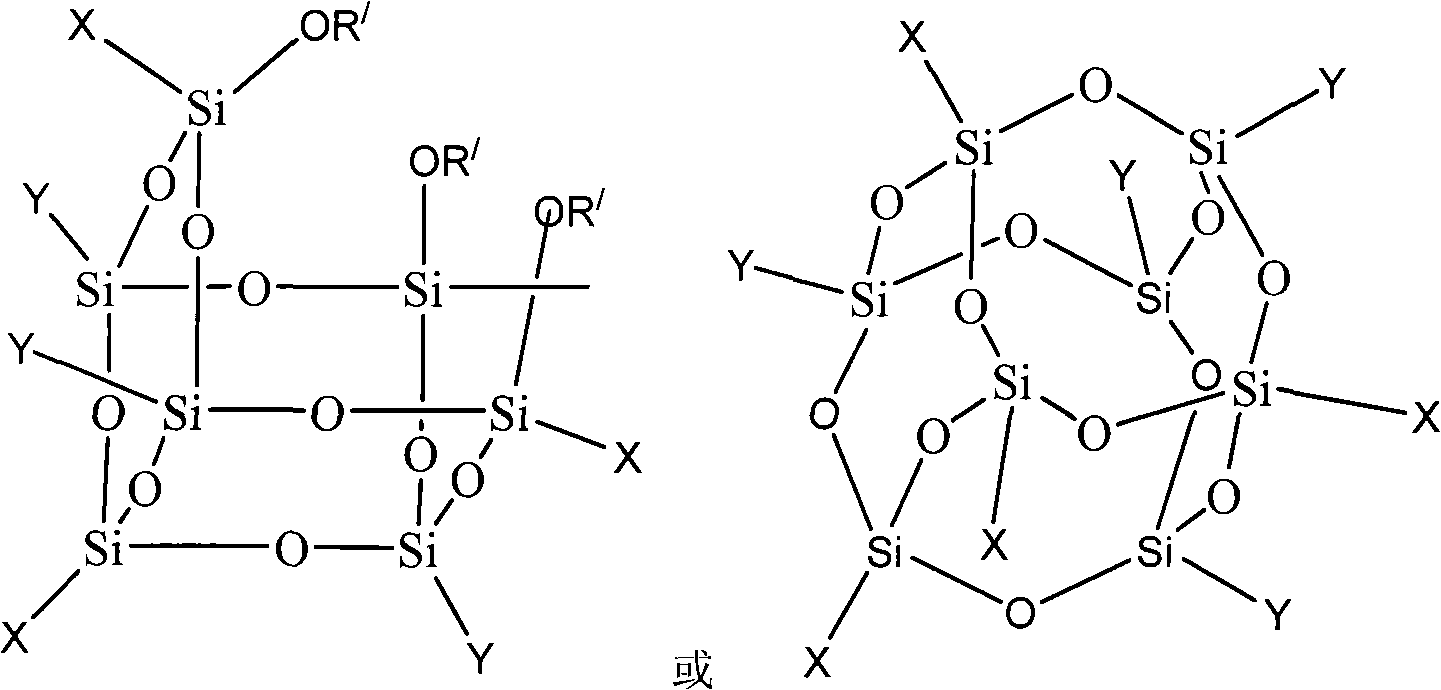Heat-resistant flame-proof phosphorus- and silicon-containing hybrid curing agent for epoxy type electronic polymer material and preparation thereof
A polymer material, epoxy-based technology, applied in the field of polymer materials, can solve the problems of thermal and mechanical properties of epoxy resins, and achieve excellent mechanical properties
- Summary
- Abstract
- Description
- Claims
- Application Information
AI Technical Summary
Problems solved by technology
Method used
Image
Examples
Embodiment 1
[0033] Add 100g of glycidoxybutyltrimethoxysilane, 20g of diethyl phosphite, 0.6g of dibutyltin dilaurate and 80g of butyl ether solvent into a three-necked flask, and reflux at 50°C for 10h. A hybrid epoxy compound containing silicon and phosphorus is obtained. Then add 20g of anilinomethyltriethoxysilane, add 50g of deionized water dropwise under stirring at 30°C, complete the dropwise addition in 30min, react under reflux for 8h, remove the solvent and small molecules by rotary evaporation to obtain phosphorus-containing silicon Heat-resistant hybrid epoxy curing agent.
[0034] Take 20g of heat-resistant hybrid epoxy resin and 100g of F51 type epoxy resin to compound, and then use 12.15g of triethylenetetramine to cure. The limiting oxygen index of the cured product is 29.2, the tensile strength is 43.4MPa, and the glass transition temperature is 167°C.
Embodiment 2
[0036]Add 100g of glycidoxypropyl dimethoxysilane, 40g of diethyl phosphate, 0.7g of triethylamine catalyst and 120g of toluene solvent into a three-necked flask, and reflux at 60°C for 8h to obtain hybrid epoxy compounds. Then add 40g of anilinomethyltriethoxysilane, add 60g of deionized water dropwise under stirring at 40°C, complete the dropwise addition in 20min, react under reflux for 6h, remove the solvent and small molecules by rotary evaporation to obtain phosphorus-containing silicon Heat-resistant hybrid epoxy curing agent.
[0037] Take 20g of heat-resistant hybrid epoxy resin and 100g of E51 type epoxy resin to compound, and then use 30.47g of diaminodiphenyl sulfone to cure. The limiting oxygen index of the cured product is 28.0, the tensile strength is 45.0MPa, and the glass transition temperature is 185°C.
Embodiment 3
[0039] Add 100g of glycidoxypropyltriethoxysilane, 50g of diethyl phosphite, 0.75g of dibutyltin dilaurate catalyst and 50g of tetrahydrofuran solvent into a three-necked flask, and reflux at 70°C for 5h , to obtain hybrid epoxy compounds containing silicon and phosphorus. Then add 75g of γ-aminopropyltriethoxysilane, add 70g of deionized water dropwise under stirring at 50°C, complete the dropwise addition in 30 minutes, react for 4 hours under reflux, and remove the solvent and small molecules by rotary evaporation to obtain phosphorus-containing Silicone based heat resistant hybrid epoxy curing agent.
[0040] Take 20g of the above-mentioned heat-resistant hybrid epoxy curing agent and compound it with 100g of E44 epoxy resin, and then use 25.12g of diaminodiphenyl sulfone to cure. The limiting oxygen index of the cured product is 27.5, the tensile strength is 44.2MPa, and the glass transition temperature is 178°C.
PUM
| Property | Measurement | Unit |
|---|---|---|
| Tensile strength | aaaaa | aaaaa |
| Glass transition temperature | aaaaa | aaaaa |
| Tensile strength | aaaaa | aaaaa |
Abstract
Description
Claims
Application Information
 Login to View More
Login to View More - R&D
- Intellectual Property
- Life Sciences
- Materials
- Tech Scout
- Unparalleled Data Quality
- Higher Quality Content
- 60% Fewer Hallucinations
Browse by: Latest US Patents, China's latest patents, Technical Efficacy Thesaurus, Application Domain, Technology Topic, Popular Technical Reports.
© 2025 PatSnap. All rights reserved.Legal|Privacy policy|Modern Slavery Act Transparency Statement|Sitemap|About US| Contact US: help@patsnap.com



